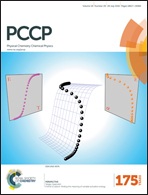Regiospecific protonation of organic chromophores†
Abstract
Highly conductive, acid doped polymers such as PEDOT/PSS and polyaniline (PANI) have attracted much attention due to their potential applications in flexible electronics. However, the understanding of the mechanism behind the doping process is still lacking. In this paper, we conduct a systematic and detailed investigation on the acid doping behaviors of four model compounds which were synthesized by combining different protonatable units such as pyridal[2,1,3]thiadiazole (PT), benzo[2,1,3]thiadiazole (BT), cyclopentadithiophene (CPDT), and azulene. DFT simulation and UV-vis-NIR spectral studies show that while the site of first protonation was mainly determined by proton affinity, the subsequent site of protonation and doping density were determined by the nature of the first protonation and influenced by the following two factors: (1) electrostatic charge repulsion and (2) the possible delocalization of protonated charge in the conjugated structure. If the first protonation occurs at heteroatoms and results in a coplanar structure, the subsequent sites of protonation are mainly determined by the distance from the positive charge center to lower the effect of static repulsion and charge delocalization. On the other hand, if the first protonation occurs on the main chain carbon atoms which induce a large torsional angle (non-coplanar) as the carbon hybridization changes from sp2 to sp3, the conformation and the possible charge delocalization in the protonated molecules will play an important role in determining the subsequent protonation. Our study provides new insight into the acid-doping mechanism of conductive polymers, which could be used as a guide to design new acid doped highly conductive polymers.


 Please wait while we load your content...
Please wait while we load your content...